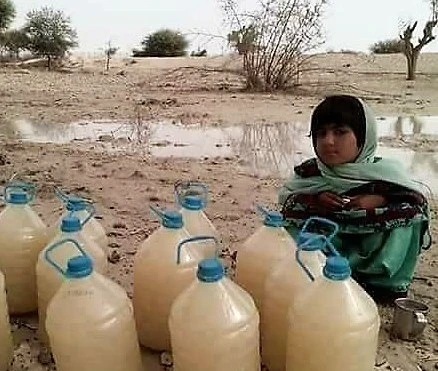More than half of Pakistan is suffering an acute water crisis. Pakistan's two large provinces—Balochistan and Sindh both face drought-like conditions.
The Pakistani media has been writing on the acute scarcity of water in the troubled province of Balochistan—which occupies over 40 per cent of Pakistan's land mass. Pakistani newspaper, The Express Tribune reports that Balochistan's capital Quetta and almost all districts of the province are running out of water.
The newspaper quotes Dr Faiz Kakar, former head of the International Union for Conservation of Nature (IUCN), as saying: "Quetta city can also turn into a desert if proper steps are not taken to control the depleting underground water table. Scarcity of water will force residents of Quetta to migrate to other parts in the future".
The situation of Balochistan: There is no education in one place,only torture,pain suffering,army insurgency, starvation,and death!There is no available drinking water in most places.Resources are being stolen and the Baloch are refugees on their own land this is true occupation! pic.twitter.com/3XdRPVFr2n
— Obeidbalouch (@obeidbalouch) May 11, 2022
The groundwater table in Balochistan has been dwindling fast.
It is a similar situation in Sindh, which hosts Pakistan's financial powerhouse Karachi, where the chief minister told the farmers not to cultivate rice this year due to the paucity of water. Cotton, a commercial crop, has been sown in a 21 per cent smaller area this year due to dwindling water supply. The province's canals too are running dry this year.
India Narrative spoke with various people to understand Pakistan's precarious water situation better.
Gauri Noolkar-Oak, transboundary river basins researcher, who has worked on river basins in Middle East, South Asia, and South-East Asia, says: "Unlike other areas of Pakistan which have glacier-fed Himalayan rivers running through them, Balochistan is dependent mainly on ground water and seasonal streams. However, as in other developmental areas, Balochistan lags in water resources development as well".
Noolkar-Oak says that Pakistan's National Water Policy mentions Balochistan only once, and that too in the context of desalination of seawater using solar energy, which is not only costly but also impractical. She implies that even in terms of management of water resources, Balochistan has been kept out of planning and development.
Regarding Sindh, Noolkar-Oak says: "Sindh's water challenges are as much a product of environmental degradation as of policy. Pakistan's conspicuous pro-Punjab tilt extends to water sharing as well, hurting downstream Sindh's interests in the process. Like in the case of Balochistan, here also Pakistan's National Water Policy displays a top-down approach".
She adds that Sindh is the lowermost riparian of the Indus River Basin – a basin that houses the world's largest contiguous irrigation system but one that is among the top ten basins most vulnerable to climate change.
Noolkar-Oak says: "The mouth of the Indus river in Sindh is already suffering – there is a distinct loss of mangroves, aquatic wildlife, and agro-based sources of livelihoods", showing that not just the environment but even people are feeling the pinch of water problems.
Every year during start of summer time, we witness same kind of situation of water crisis in Sindh. Punjab causing hindrance in releasing water from dams and IRSA justifying themselves.
A blog on water crisis from last year.#SindhNeedsWater https://t.co/X0D61hiGYD— Nazia Memon (@Nazia_Memon48) May 4, 2022
The crisis in two of Pakistan's important provinces is only exacerbating the country's fault lines.
Last year, when the masses turned out in large numbers in Balochistan's Gwadar port under the banner of "Gwadar ko Haq do", their demand also included the basic right to water. The Balch have been buying expensive water through tankers to meet their daily demands. Often people have been drinking contaminated water leading to diarrhea among children.
In Balochistan, Pakistan's shoddy governance has ensured that the Baloch remain a poverty-ridden, deprived community with the lowest development indicators for education, health and livelihoods. No wonder the Baloch nationalists have been shouting discrimination and exploitation of their resources, fuelling a full-scale armed rebellion.
Regarding Sindh, which too exhibits a strong nationalist streak, Zafar Sahito, founder and Central Chief Organiser of the Jeay Sindh Freedom Movement (JSFM), told India Narrative that the acute shortage of water in Sindh has been engineered by Pakistan and China through the construction of dams and canals on the Indus river.
Sahito says: "The people of Sindh have always opposed the construction of new dams and canals on the Indus, but Pakistan's dominating Punjab province has always regarded Sindh as its colony and has taken a lion's share of the water, depriving the Sindhi's of their rightful quantity".
The Sindhis blame China for the various ills plaguing their province.
Alluding to China's activities in Pakistan, the US-based activist says that Sindh's water problems mounted after China began constructing hydropower dams on the Indus. Sahito says that China took on the massive construction after a series of rejections–the Asian development bank (ADB) refused to fund the project, so did the World Bank and also the US. He says that though these massive projects have provided water to Punjab, they have taken that water from Sindh's people.
With Beijing-Islamabad iron-friendship at play, cemented by Pakistan's poor water management strategies, the common man in two of its largest and important provinces stares at dry fields, parched earth and thirsty cattle.


















